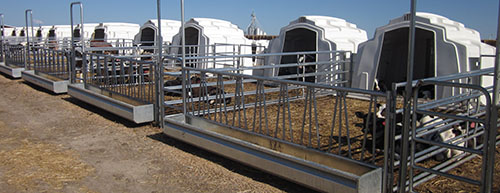POLY GROUP HUTCH™
How Group Hutches™ Work
- Group Hutches™ serve as a transitional "half-way house"... after living in a single-calf hutch... but before adjusting to a large group
- Weaned calves transferred from isolation to a Group Hutch™ can gradually adjust to similar-sized calves (and will actually bond for protection)... before transfer to a large group
- Calves can be moved earlier from isolation to a Group Hutch™, due to less competition for food... and less social stress... than found in a large herd
- Group Hutches™ avoid the setbacks in weight and health that often occurs from direct transfer to a large herd... by delaying the added competition for food... the increased nose-to-nose contact... and the higher social stress
- Group Hutches™ provide the highest daily weight gain when it's most important... during a calf's early months
- Each calf's health can be monitored more easily in a Group Hutch™ vs a large group
When to Transfer Calves to a Group Hutch™
- Transfer calves as soon as weaned
- Wean based on grain intake vs age (less than 45 days on average)
- Wean calves as soon as they are consuming 2.1 lbs. of grain per day for three days
- Transfer similar-sized calves to the same Group Hutch™... to minimize social stress and reduce competition for food
Group Hutches™ Can Reduce Investment Per Calf by Up to 50%
- Fewer single-calf hutches are required, as calves can be transferred earlier to Group Hutches™ — so emptied single-calf hutches are available sooner
- The investment in a Group Hutch™ is spread out over groups of calves vs. single calves
- Feeding and cleaning time per calf is less with a Group Hutch™ vs. with single-calf hutches
- Faster weight gains and fewer health problems are found with Group Hutches™ vs. direct transfer from isolation to larger groups
Group Hutch™ Operation Tips
- Position front of hutch toward warmer, southerly winds
- Locate hutches on either:
- gravel or sand base with good drainage
- pasture with good drainage
- Locate water and feed minimum of 24' straight out from front of hutch
- Allow approx. 50 square feet of pen space per calf when computing length of pen
- Use 16' cattle panels as needed for the computed length of pen
- Place similar-sized calves in each group hutch... for maximum weight gain
- Feed calves twice per day — changing from grain to forage
- Calves can remain in Group Hutch™ up to 500 lbs. (approximately 5 to 6 months old)
- Sanitize hutch after each group of calves has been transferred
- Remove bedding and manure, and rotate hutch to new location (rotate back to original location for next group)
- Vinyl-strip door material is available from us for very cold/windy climates — see our Loyal Catalog
Group Hutch™ Uses Are Unlimited
- Group housing for goats, llamas, mini-horses, hogs, sheep, chickens, ostriches, etc.
- Feed storage — dry, cool and portable
- Utility shed — equipment, tools, lawn/garden supplies, etc.
- Ice-fishing shanty (vinyl-strip door material available) — see our Loyal Catalog
- Transitional housing — after isolation but before transfer to a larger group
- Steel pen shown for illustrative purposes only... not included with group hutch

